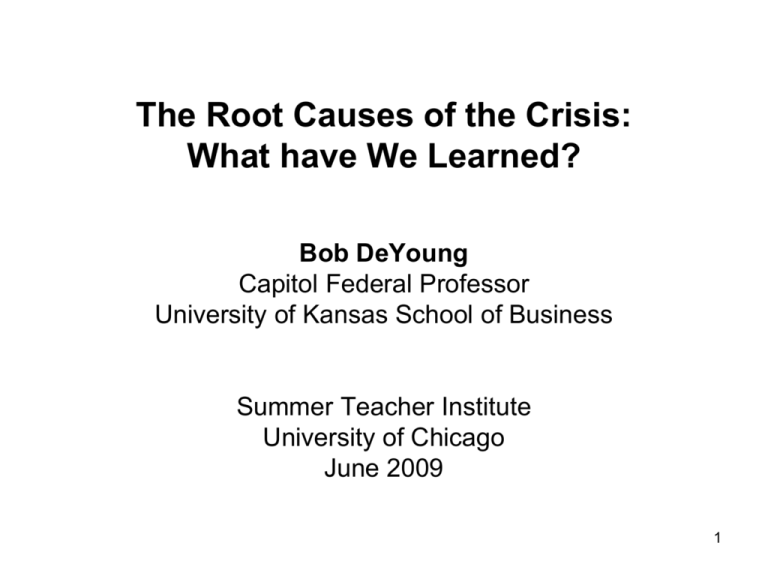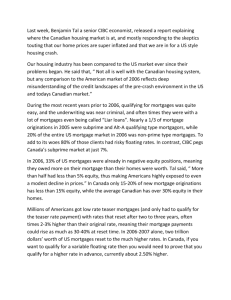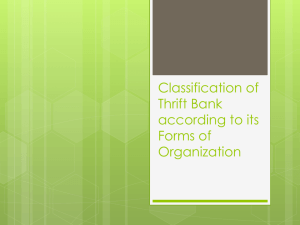What Have We Learned? - Center for International Studies
advertisement

The Root Causes of the Crisis: What have We Learned? Bob DeYoung Capitol Federal Professor University of Kansas School of Business Summer Teacher Institute University of Chicago June 2009 1 Case-Shiller Home Price Index 250 From 1997 to 2006, home prices increased at a 9.1% annual rate. 200 150 100 Home prices have declined more than 25% since 2006. 50 2009 2008 2007 2006 2005 2004 2003 2002 2001 2000 1999 1998 1997 1996 1995 1994 1993 1992 1991 1990 1989 1988 1987 0 2 % of Jobs Lost in Past Recessions 2 1 1960 1969 1973 1981 1990 2001 2007 0 -1 -2 -3 -4 -5 0 2 4 6 8 10 12 14 16 18 20 22 24 26 28 30 months 3 % of Jobs Lost in Past Recessions 2 1 1960 1969 1973 1981 1990 2001 2007 0 -1 -2 -3 -4 -5 0 2 4 6 8 10 12 14 16 18 20 22 24 26 28 30 months 4 % of Jobs Lost in Past Recessions 2 1 1960 1969 1973 1981 1990 2001 2007 0 -1 -2 -3 -4 -5 0 2 4 6 8 10 12 14 16 18 20 22 24 26 28 30 months 5 % of Jobs Lost in Past Recessions 2 1 1960 1969 1973 1981 1990 2001 2007 0 -1 -2 -3 -4 -5 0 2 4 6 8 10 12 14 16 18 20 22 24 26 28 30 months 6 % of Jobs Lost in Past Recessions 2 1 1960 1969 1973 1981 1990 2001 2007 0 -1 -2 -3 -4 -5 0 2 4 6 8 10 12 14 16 18 20 22 24 26 28 30 months 7 % of Jobs Lost in Past Recessions 2 1 1960 1969 1973 1981 1990 2001 2007 0 -1 -2 -3 -4 -5 0 2 4 6 8 10 12 14 16 18 20 22 24 26 28 30 months 8 % of Jobs Lost in Past Recessions 2 1 1960 1969 1973 1981 1990 2001 2007 0 -1 -2 -3 -4 -5 0 2 4 6 8 10 12 14 16 18 20 22 24 26 28 30 months 9 My talk today All recessions are different. This recession was caused by a collapse in residential real estate values. Real economy: Home prices fell Housing sector collapsed Aggregate spending declined. • This is a demand-side story. • Reduced spending on houses and related items. Financial sector: Mortgage defaults Big losses on mortgage-backed securities Investor uncertainty. • This is a supply-side story. • Less credit available for businesses and households. 10 My talk today 1. Root causes of the recession: – A bubble in the housing market. – A new lending model (which performed poorly). – A history of short-sighted economic, financial, and social policies. – Bad financial behavior by households. 2. What have we learned? – Have the responses of policymakers been appropriate? – Have households changed behavior? 11 Root Causes of the Crisis: • Housing bubble. • A new banking model. • Poor historical public policy. • Poor household finance. 12 Rate of Homeownership in U.S. 75% 70% 65% 60% 55% 50% • GI Bill 45% • Automobile/Suburbs 40% • High income tax rates. 2008 2006 2004 2002 2000 1980 1960 1940 1920 1900 35% 13 Rate of Homeownership in U.S. 75% 70% 65% 60% 55% • Affordable home policies. 50% 45% • Easier access to mortgage credit. 40% 2008 2006 2004 2002 2000 1980 1960 1940 1920 1900 35% 14 Case-Shiller Home Price Index 250 From 1997 to 2006, home prices increased at a 9.1% annual rate. 200 150 100 50 2009 2008 2007 2006 2005 2004 2003 2002 2001 2000 1999 1998 1997 1996 1995 1994 1993 1992 1991 1990 1989 1988 1987 0 15 Home Price Increased House Demand • Easy Federal Reserve monetary policy. • Mortgage interest tax deduction. • Policies to provide "affordable housing." • Ownership Society. • Originate-to-Securitize banking model. Home Sales 16 Distribution of Assets held at Financial Intermediaries in the U.S. 1970 Depository Institutions (banks, thrifts, credit unions) Insurance Companies (life, property & casualty) Pension Funds (public, private) 54.4% Banks were the center for: 17.4 • Personal savings 14.6 Mutual Funds (stock, bond, money market) Securities Firms (brokers, dealers, funding corps.) • Business credit • Payments Mortgage and Consumer Finance (GSEs, finance companies, REITs, securitized asset pools) 2007 8.8 3.7 1.2 17 Distribution of Assets held at Financial Intermediaries in the U.S. Depository Institutions (banks, thrifts, credit unions) Insurance Companies (life, property & casualty) Pension Funds (public, private) 1970 2007 54.4% 22.8% 17.4 10.5 14.6 16.9 8.8 23.3 3.7 18.5 1.2 7.9 Mortgage and Consumer Finance (GSEs, finance companies, REITs, securitized asset pools) Mutual Funds (stock, bond, money market) Securities Firms (brokers, dealers, funding corps.) 18 1.5% 60% Bank profits as % of GDP 50% 1.0% 40% 30% 0.5% 20% 10% 0.0% 0% 1970 1980 1990 2000 Asset share of banks, thrifts, credit unions 2007 19 Bank asset shares plunged, but bank profits soared. Why? • A new business model for large banks emerged. • The new model exploits post-1980s information technologies, financial products, and regulations. – Much activity at banks moved off the balance sheet. – Much income at banks now comes from fees, not from interest. • This new model is highly efficient, highly profitable, but riskier than most of us thought. 20 Traditional Mortgage Finance Agents that need funds Agents with excess funds Home Buyers Depositors $ funds $ $ funds $ Bank or Thrift mortgages deposits Bank earns profits from interest margins. 21 Innovation: technology and deregulation • Geographic deregulation (Riegle-Neal Act 1994) – Permitted inter-state branching. – Banks could exploit scale economies. • Product deregulation (Gramm-Leach-Bliley Act 1999) – Permitted commercial banks to engage in investment banking, securities brokerage, and insurance sales. – Largely fee-based, off-balance sheet activities. • New technologies – Credit bureaus and credit scores. – Automated loan underwriting. – Loan securitization. – Deeper capital markets. 22 Traditional Mortgage Finance Agents that need funds Agents with excess funds Home Buyers Depositors $ funds $ $ funds $ Bank or Thrift mortgages deposits Bank earns profits from interest margins. 23 Traditional Mortgage Finance Agents that need funds Agents with excess funds Home Buyers Depositors $ funds $ $ funds $ Bank or Thrift mortgages deposits 24 Mortgage Securitization Bank or Thrift mortgages deposits 25 Mortgage Securitization Bank or Thrift mortgages cash deposits $$$ mortgages Mortgage Pool (off-Balance Sheet) mortgages 26 Mortgage Securitization Institutional Investors Bank or Thrift mortgages cash deposits MBSs MBS $$$ $$$ mortgages MBS Mortgage Pool (off-Balance Sheet) mortgages mortgages mortgage-backed securities (MBS) 27 Mortgage Securitization Institutional Investors Bank or Thrift mortgages cash deposits Mortgage payments from Households MBSs MBS Loan servicer (often the bank or the securitizer) withholds a small fee from each mortgage payment. Mortgage Pool (off-Balance Sheet) mortgages mortgages Payments go to investors based on terms of the MBS contract. mortgage-backed securities (MBS) 28 Mortgage Securitization Bank or Thrift mortgages cash deposits $$$ mortgages Institutional Investors Bank earns profits from origination fees, securitization fees, servicing fees. Investors get the principal & interest payments. MBSs MBS $$$ MBS Mortgage Pool (off-Balance Sheet) Credit scoring allows a bank to make more loans faster. mortgages mortgages mortgage-backed securities (MBS) MBS rated by Moody's, S&P or Fitch. 29 This model increased risk at large banks. • Increasing reliance on fee income. – Fee income is often more volatile than interest income. – Fee-based activities require higher operating leverage. – Fee-based activities are off-balance sheet, allowing banks to use more financial leverage. – Fee income has not yielded expected diversification benefits. • Increasing reliance on third-party information. – All lenders have same information (credit bureaus). – Investors (firms and funds that own the MBS) rely on bond raters. • Fundamentally poor financial management. – – – – – A lack of diversification. Excess reliance on financial leverage for earnings. Too much interest rate risk. Modeling risk without adequate historical data. Why? Did large banks know they were Too-Big-To-Fail? 30 Model gives banks incentives to make riskier loans…that others will hold! • Credit underwriting separated from risk-bearing. – Incentives for lenders to make riskier loans. • Securitization separated from risk-bearing. – Incentives for investment banks to engineer riskier MBS. • Loan monitoring separated from risk-bearing. – Investors must rely on opinions of rating firms…and the rating firms get paid by the securitizing banks. • Control rights separated from risk-bearing. – Fractured ownership of mortgages impedes the modification of nonperforming mortgage loans. 31 Bad banking model? Or bad policy? • Regulation did not evolve with banking practices. – Bank moved activity off of their balance sheets. – This circumvented capital rules; increased leverage. • SEC reduced capital requirements for largest five investment banks in 2004. • Regulators did nothing to rein in "Too-Big-To-Fail." • SEC limits competition in securities rating business. – Only three main NRSROs (Moodys, S&P, Fitch) have been licensed to rate these securities. 32 Bad banking model? Or bad policy? • Congress made sure that OFHEO was a weak regulator of Fannie Mae and Freddie Mac. – Congress wanted more "affordable mortgages." – Pressured Fannie and Freddie into providing funds for subprime mortgage securitizations. 33 Many households also at fault. • Too much mortgage debt. – Bigger houses – Small down payments – Home equity loans 34 Household Financial Obligations (% of Disposable Income) 35% 30% 25% Renters All households Homeowners Mortgage Debt 20% 15% 10% 5% 2007 2004 2001 1998 1995 1992 1989 1986 1983 1980 0% 35 Subprime mortgage lending • A typical subprime mortgage scenario in mid-2000s: – Borrower cannot qualify for a conforming mortgage. – Gets a 3-year ARM: 0% down and a teaser rate. – Borrower can just afford the payments in years 1-3. – Borrower cannot afford the payments after year 3. • Deal works out only if home prices keep increasing. – As prices rise, borrower builds up equity in home. – Borrower builds credit rating with a good payment record during first 3 years. – At year 3, borrower refinances with a conforming loan at a low fixed rate. • But what if prices stop going up? 36 Case-Shiller Home Price Index 250 Home prices have declined more than 25% since 2006. 200 150 A profound effect on the economy. 100 50 2009 2008 2007 2006 2005 2004 2003 2002 2001 2000 1999 1998 1997 1996 1995 1994 1993 1992 1991 1990 1989 1988 1987 0 37 Excess Supply Home Price Reduced House Demand • Prices stop rising… • Levered homeowners stop building equity. • Refinancing is no longer possible. • As these homeowners default on mortgages… • Investors wary and stop financing MBS. • Mortgage loans become scarce. Home • As prices fall, buyers wait for a good deal. 38 Sales Single-family Housing Starts (thousands per quarter) 600 500 400 300 200 NAHB estimates: Building one single-family home generates about 3.5 jobs. 100 Rough calculation: The annual decline in 0 starts since 2006 implies 4.2 million fewer 2002 approximate 2003 2004 2005 2006 jobs…an 3% reduction in jobs. 2007 2008 39 % Change in Aggregate Spending (Annualized change from previous quarter, seasonally adjusted) 20% 15% 10% 5% Consumption Spending Nonresidential Investment Residential Investment 0% -5% -10% -15% -20% -25% -30% 2006 2007 2008 40 % Change in Aggregate Spending (Annualized change from previous quarter, seasonally adjusted) 20% 15% 10% 5% Consumption Spending Nonresidential Investment Residential Investment 0% -5% -10% -15% -20% -25% -30% 2006 2007 2008 41 % Change in Aggregate Spending (Annualized change from previous quarter, seasonally adjusted) 20% 15% 10% 5% Consumption Spending Nonresidential Investment Residential Investment 0% -5% -10% -15% -20% -25% -30% 2006 2007 2008 42 Impact on the Financial Sector • Large capital losses at banks. – U.S. banks will suffer at least $2 trillion from MBS losses. – About $1 trillion of these losses remain to be taken. – Based on estimates from IMF; Goldman Sachs; Nouriel Roubini. – Largest U.S. banks propped up by the tax payers. • Massive operating losses at mono-line mortgage firms. – Novastar, Countrywide, American Century, WAMU, IndyMac, and others have failed. • Lender losses created uncertainty in financial markets. – No new private mortgage securitizations in over a year. – BX 2007 AAA-rated subprime trading at 24¢. 43 % Delinquencies at U.S. Commercial Banks 14% 12% 10% Credit cards 8% Business Loans Single-family mortgages 6% Commercial mortgages 4% 2% 2008Q3 2007Q2 2006Q1 2004Q4 2003Q3 2002Q2 2001Q1 1999Q4 1998Q3 1997Q2 1996Q1 1994Q4 1993Q3 1992Q2 1991Q1 0% 44 Subprime Mortgage Delinquencies NOTE: Most subprime mortgages written by non-banks. 45 Lending at U.S. Banks ($ billions) $1,800 $1,600 $1,400 $1,200 $1,000 $800 $600 $400 $200 $0 Commercial Loans Interbank Loans Jan- Jul- Jan- Jul- Jan- Jul- Jan06 06 07 07 08 08 09 46 Rates on 3-month financial securities 7% 6% 5% 4% Financial CP Non-Financial CP Treasury Bills 3% 2% 1% 2009-01 2008-01 2007-01 2006-01 2005-01 2004-01 2003-01 2002-01 2001-01 2000-01 1999-01 1998-01 1997-01 0% 47 2008-12-22 2008-10-30 2008-09-10 2008-07-22 2008-06-02 2008-04-14 2008-02-25 2008-01-07 2007-11-19 2007-10-01 2007-08-13 2007-06-25 2007-05-07 2007-03-19 2007-01-29 2006-12-11 2006-10-23 2006-09-04 2006-07-17 2006-05-29 2006-04-10 2006-02-20 2006-01-02 48 2009-02-10 Daily New Issues of Financial Commercial Paper, 2006-2009 400 350 300 250 200 150 100 50 0 What Have We Learned? • Have the policy responses been appropriate? • Have households responded appropriately? 49 Congress • Silly populist legislation: – Tax AIG bonuses (ex post). – Limit executive pay (ex post). – Tank the corporate jet market. • Efforts to modify mortgages. – Gives households moral hazard incentives. – OCC study: High recidivism rate. • "TARP-plus" funding. – A $115 billion ransom payment to get bill passed. • Hair of the dog: – $8,000 tax credit for first-time home buyers. – 3% down payments for VA, FHA and FMHA loans. 50 SEC • Largely a bystander in the post-crisis policy response. 51 FDIC • New FDIC guarantees: – Deposits up to $250,000 – Pre-existing MMMF accounts – Newly issued corporate debt • Failed bank resolutions: – Allowed historically large bank failures. – An hour away from arranging a subsidized purchase of Wachovia by CitiGroup. • Financing the insurance fund: – Increased deposit insurance premiums paid by banks. – $500 billion line of credit from Treasury. 52 • Leading the charge on modifying mortgages. Federal Reserve • New lending facilities: – Term Auction Facility – Commercial Paper Funding Facility – Term Securities Lending Facility – Primary Dealer Credit Facility • Aggressive monetary policy response – Fed funds target rate is near 0%. – M1 and M2 have exploded. • Co-conspirator with Treasury on "bailouts" – Fannie and Freddie (discount window loans) – AIG ($152 billion credit facility) – Bear Stearns ($29 billion loan to J.P.Morgan Chase) 53 Treasury • Bailouts – Fannie and Freddie; AIG; Bear Stearns…not Lehman? • TARP (Troubled Asset Relief Program) – Still hasn't bought a single $1 of troubled assets…but it is keeping Citi and BofA afloat. • The Hotel Geithner • Son of TARP 1. Public-Private investment partnerships to purchase troubled assets. 2. Inject more capital (as previous TARP is paid off). 3. Loan modifications 4. Provide funding in ABS markets (w/ FDIC and Fed) 54 The New Administration Proposal • Announced on Wednesday, June 17. • Five point plan: – Federal Reserve becomes the regulator of all large or systemically important financial firms. – Requires reforms in securities markets (ratings firms, securitized loans, derivatives). – Creates the Consumer Financial Protection Agency (CFPA). – Established procedures for federal government to takeover and "unwind" large failing financial firms. – Encourages other countries to do this, too. • Details to come… 55 First National Too-Big-To-Fail Bank MBS $100 ($25 market) Loans $900 $1,000 Deposits $ 0 Equity 1. FNB marks MBS to market: Equity = -$75. Bank fails. FDIC takes a $75 loss. 2. Treasury buys MBS for $100: Equity = $0 and Cash = $100. Treasury takes a $75 loss when it sells MBS. 3. Treasury injects $75 of equity: Bank sells MBS and loses $75. Equity = $0 and Cash = $100. Treasury takes a loss of $75 on equity investment. 56 Household Behavior A 14-year high level of household savings. 57 The Root Causes of the Crisis: What have We Learned? Bob DeYoung Capitol Federal Professor University of Kansas School of Business Summer Teacher Institute University of Chicago June 2009 58








